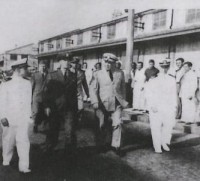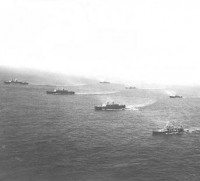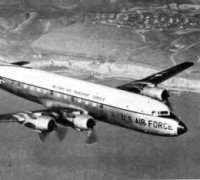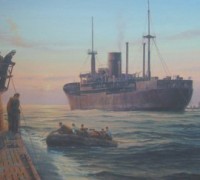COMMANDER SOUTH ATLANTIC FORCE AT RECIFE - COMMANDER SOUTH ATLANTIC
31)OPERATIONS THE LATER EVENTS
Following the successful conclusion of the "Solant Triple Play" operational activities in the South Atlantic reverted to routine., unbroken save for occasional intervals. They can be reconstructed with relative brevity.
For the remainder of January, which was taken up largely with the aftermath of the blockade runners episode, little occurred beyond the ordinary. On the 9th, the Carib boarded the Spanish merchant ship Monte Amboto outside Bahia, and took off a German stowaway, allegedly an internee in Argentina from the Graf Spee, the pocket battleship sunk off Montevideo by the British late in 1939. The purpose of this removal was interrogation. On the 17th, the K-36 (Blimp) stationed in Rio, crashed in a fog off Cabo Frio, not far from the Brazilian Capital. The crew consisted of nine officers and men, of whom two received slight injuries. Otherwise, convoys moved on schedule with no excitement or unusual features.
On the 6th of February, and Ascension based Liberator of Bombing Squadron 107 attacked and sank a submarine in position 10° 35' S, 23° 12' W, after sighting it at a distance of two miles. The co-pilot made out the enemy craft, whereupon the plane approached it at about a mile altitude and suddenly dropped through the clouds at a steep decline. The released bombs enveloped the German sub, which commenced firing as the Liberator swept over the conning tower. The plane's rudder was lost and the nose dropped badly, but Lieutenant Dawkins, the pilot, slowly pulled his ship up to 800 feet. A large oil slick appeared around the sub, whose crew by this time were all on deck. Suddenly the U-Boat exploded, some parts flying 200 feet into the air. Two days later, the Commander Task Force 41.1, in the Omaha recovered 14 survivors, consisting of two officers, two petty officers, and ten seamen. They told of being from the submarine in question, which they reported as sunk, and the Captain dead. Since no other known circumstances accounted for their presence and condition, there seemed no reason to doubt the story.
The only other item for February was the forcing down of a PBY at sea on the 29th. This was not the result of enemy action, mechanical difficulties alone being responsible. A Brazilian escort from a convoy found the plane and towed it to Rio, the nearest important harbor. The PBY received no damage and the crew escaped unhurt. In March, Admiral O. M. Read was detached as Commander Cruiser Division II, to assume duty as Commandant NOB Trinidad. April saw the 19th Provisional Marine Company detached from the Fourth Fleet and returned to the United States. The Marines had been stationed first at Recife and then Ibura since the end of December 1941, a little after Pearl Harbor. Their silent departure was in singular contrast to their much heralded coming, which, it will be remembered, had occasioned almost a diplomatic crises between the United States and Brazil.
One submarine was sunk in April. This kill took place on the 10th when an Ascension based Liberator attacked and destroyed the enemy craft in position 15° 37' S, 17° 00' W. The U-Boats also scored. Late in the month they torpedoed the British SS Nebraska, survivors of which were picked up near the mouth of the Sergipe River by the Brazilian Turuena. Another boatload arrived safely in Recife.
During May a submarine accounted for one steamer, the Janeta, sunk on the 12th in position 14° 12' S, 20° 00' W. Ten survivors were later picked up by the USS Alger. Also during the month, the PC 1234 was transferred to the Uruguayan flag. On the 15th of June there was encountered probably the toughest submarine that the Fourth Fleet had dealt with as yet. In March, the Carrier Solomons had entered the area and had come under the temporary operation control of the Admiral. She was, on June 15, patrolling a little south of the Latitude of Rio and well to the east, somewhat below St. Helena.
The affair began when Ensign G. E. Edwards took off from the Carrier in the morning on a regular anti-submarine patrol. At 1021 he reported a contact, bearing 070° (T), distant 50 miles from the Solomons. There was no further communication from him. Survivors from the submarine subsequently stated that he had attacked and made four runs in the face of concentrated anti-aircraft fire. On the last run his plane was hit and crashed into the sea. From later evidence it would seem that Ensign Edwards had not taken time to ascertain the position accurately.
Lieutenant Commander H. M. Avery next took off, to conduct a normal square gambit over the reported contact and to look for Ensign Edwards and the U-Boat. Not long before sunset, while at an altitude of 1500 feet, he sighted what seemed to be a wake, bearing 030° (T), distance 10 to 12 miles. He closed and ascertained this to be the wake of a fully surfaced submarine. This was about 50 miles from the position previously given by Ensign Edwards. As Lieutenant Commander Avery's plane approached, the enemy instead of submerging began to maneuver, running in circles of about 1000 feet in diameter, and keeping the aircraft on his stern. From the sub came intensive anti-aircraft fire at the plane, whose pilot circled while awaiting assistance. Somewhat earlier in the afternoon, Ensigns T. J. Wadsworth, R. E. McMahon, and M. J. Spear had taken off from the Carrier to investigate the contact reported by Ensign Edwards. Failing to find anything at that specified position, they had been on the point of landing on the Solomons at 1720, when they were suddenly sent to the scene of the new contact. They arrived over the target at 1743.
The entire attack on the submarine was delivered in three phases, commencing at 1746, eight minutes after sunset, and ending at 1753. Lieutenant Commander Avery took charge and ordered Wadsworth and McMahon to begin strafing attacks on the starboard and port quarters respectively, while Spear and the Lieutenant Commander coordinated a rocket attack. Wadsworth made his strafing attack from the starboard quarter, and pulled out at less than 100 feet directly over the conning tower, amid many bursts of anti-aircraft fire. He expended 400 rounds of ammunition. McMahon, meanwhile had commenced his strafing run in a steep dive from 3000 feet, due to the sub's incessant maneuvering. He peppered the deck and conning tower with 200 rounds and then pulled out to clear the target for the first rocket attack.
Spear came in next, on the U-Boat's starboard beam, and on reaching 800 yards slant range he launched 8 rockets in pairs. Six of these hit a lethal area slightly ahead of the conning tower; the other two missed. On firing the last rocket, he pulled to the left and gave his gunner a chance to strafe. Almost simultaneously, Lieutenant Commander Avery had made his attack from the port beam, and planted six projectiles in a lethal area 20 feet ahead of the conning tower. These actions constituted phase one of the attack. All four planes had passed over the enemy within 10 seconds. The submarine had straightened out on course 180° (T) at a slowing speed, trailing oil and smoking around the conning tower, but still directing anti-aircraft fire in bursts toward the planes. Ensign Wadsworth had been ordered back to the Carrier, having suffered a damaged wing tank he could not jettison, but Lieutenants (jg) W. F. Chamberlain and D. E. Weigle had meanwhile taken off from the Solomons and arrived almost simultaneously on the scene.
Phase two began with McMahon making another successful strafing run, during which he expended the rest of his ammunition, followed by a rocket attack by Weigle. The latter fired 8 more, 6 of which hit the lethal area in front of the conning tower. At the conclusion of this phase, the sub continued on course 180° (T) but with speed now reduced to 3 knots. Large quantities of greenish yellow oil showed on the surface. To start phase three, Chamberlain was ordered to begin a depth charge run from the port quarter. He paid no heed to the burst of AA fire but released two charges at an altitude of less than 50 feet, directly over the conning tower. They caused a violent explosion which engulfed his plane, of which he maintained control just long enough to make a 180° turn and land in the water about 500 yards ahead of the U-Boat. Chamberlain, with his gunner and radio man, could not be rescued.
Lieutenant Commander Avery had gone in just ahead of the depth charge run to strafe, after which he pulled up into a chandelle (climbing turn) to the right enabling his gunner to get several bursts on the conning tower. Before the three VTBs still over the target could get into position to make the final killing attack, the U-Boat had gone down, bow first, leaving 30 to 40 survivors struggling in the water. By estimate, this submarine was of the 1200 ton operational type. Her length was between 200 and 300 feet, and she had 4 to 6 AA guns in the bandstand aft of the conning tower. The gunners aboard the sub had good armor protection, because despite the strafing attacks they continued to fire until they went down. Photographs taken from the planes during the action turned out blank, since the attack occurred after sundown. Toward midnight the USS Straub picked up 21 survivors from the sub, including the Captain and Executive Officer.
During July and August, the action continued light, yet there was just enough to show that the campaign had not ended. Submarines continued at intervals to sink or damage surface vessels. The Vital de Oliveira, Brazilian, went down in 22° 30' S, 41° 00' W, on July 20, leaving 70 survivors to be rescued by the Javari. Next day the Brazilian Navy suffered a loss when one of its Corvettes, the Camaquã, capsized and sank in 08° 10' S, 34° 20' W, and occurrence not due to enemy action.
Evidence of another sinking came on the 24th, when a PBK of Patrol Squadron 203 sighted three lifeboats with survivors, in southerly Latitude. The USS Matagorda received orders to go to the rescue and the next day took on board what proved to be the entire crew of the SS William Gaston. Without having sighted her assailant, the merchant vessel had been attacked twice with torpedoes on July 24 in position 26° 42' S, 46° 12' W. On the 26th the Brazilian Destroyer Greenhalgh reported being attacked by torpedo, without apparently having made a sound contact or any attempt at retaliation. August was the month of patrols and convoys. No submarine contacts occurred, and the only loss was that of a PBY and a Ventura, both of which were forced down near Natal at the end of the month. Survivors from both planes were rescued, and enemy action did not account for the loss.
A final sub kill, not necessarily the last in the Fourth Fleet's history, but the last that can be included in this narrative, came on September 29. At 0702 on that date, a Navy heavy bomber, piloted by Lieutenant J. T. Burton, sighted, attacked and seriously damaged an enemy sub at 10° 45' S, 25° 30' W. After injuring the U-Boat, Lieutenant Burton homed another plane piloted by Lieutenant E. A. Krug, Jr., to the scene. Subsequently they made three additional co-ordinated attacks, in the face of heavy anti-aircraft fire. At 0722, twenty minutes after the first contact, they destroyed the submarine by co-ordinated attacks, the bombs of Lieutenant Krug's plane finally making the kill. Life rafts were dropped to many survivors swimming in the water, and at 0748 both planes departed for base, having reached their prudent limit of endurance. The pilots received recommendations for the Distinguished Flying Cross, and the other personnel involved were named for Air Medals. With this last successful episode we must bring to an end the action side of the South Atlantic's story.
Hyper War. Commander South Atlantic Force. U.S Naval Administration in WW II.



